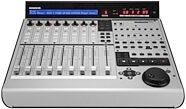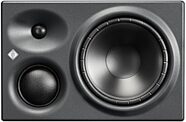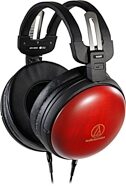
Mackie Control Universal Pro 8-Channel Master Controller with USB
Compatible with every major DAW and video software out there, Mackie's MCU 8-channel controller puts touch-sensitive 100 mm faders at your fingertips.
$1,299.99
- 18 x$72.22
- 12 x$108.33
- 8 x$162.50
Emagic Logic Control Logic 5 Control Surface
No longer available at zZounds
Multi Channel View/Channel Strip View. High-speed RISC microcontroller.
Overview
Unleash the power of Logic Audio 5 with this ingenious creation from Emagic and Mackie. Are you tired of using the mouse for everything, and long for the old days of mixers? Here's your solution.
Multi Channel View/Channel Strip View
Logic Control knows 2 different modes of operation: Multi Channel View/Channel Strip View:
Multi Channel View - you see one parameter for all tracks.
Channel Strip View - you see several parameters of a function "block" - EQs, as an example - for the selected track.
Switching between these modes is achieved via a simple key press.
LC Display
The LCD (dependent on the current mode) displays a range of different information.
Parameter names and values usually refer to the V-Pot directly below the entry in the LCD.
The information shown in the LCD can be switched between parameter names and values.
When in Multi Channel View, the upper row of the LCD always displays the track name. The lower LCD row displays the parameter name or the parameter value of the parameter currently controlled by the V-Pots.
In Channel Strip View, the upper row of the LCD displays the parameter name and the lower LCD row indicates the parameter value.
Alternately, the upper row of the LCD will show the name of the selected track, the selected function area and the current page inside the selected function area (if there are several pages). In this mode, the parameter names appear in the lower row of the LCD.
Switching between these modes is via a simple key stroke.… read more
As an example: If you use an Audio Instrument like the ES1, there are 33 parameters. Now, imagine a configuration of one Logic Control and an additional XT unit. In channel strip mode you can edit a maximum of 16 parameters, in parallel, with the V-Pots. To edit the next 16 parameters, you need to switch to the next "bank" of 16 parameters/V-Pots a.s.o. With a more complex Audio Instrument, the number of "banks" increases. If you only have a Logic Control without an XT unit, there would be 5 "banks" for the ES1. (4 x banks, each containing 8 V-Pots for the first 32 parameters, and another bank for the 33rd parameter.
Level Metering
Signal LED: indicates signal presence for a track (audio and MIDI).
Optional level meter: If the signal LED's are insufficient for your needs, a horizontal level meter can be displayed on the lower row of the LCD display.
Display of Peak Hold (as known from the audio objects)
Permanent display of overloads (can be reset)
The display of level meters does not require any additional MIDI bandwidth.
Turn on/off via a single key stroke.
V-Pots/V-Selects
Fast response to the rotation of V-Pots results in smooth and precise value changes.
The circular LED segments surrounding each V-Pot display the current parameter value. This will vary as follows, dependent on the selected parameter:
Single segment (e.g. panorama, frequency)
Connected series of LED segments from left to right (e.g. send level)
Connected series of LED segments, starting in the center position and fanning to the left OR right (e.g. EQ gain)
Series of connected LED segments, starting in the center position and fanning to the left AND right (e.g. Q-Factor)
An LED indicates when the parameter value is in the centered/default position
Use of the V-Select button generally resets the currently selected parameter to it's default value. If a parameter has only 2 values, V-Select toggles between these 2 values. V-Selects can also used for (de)activating certain modes, for which no hardware buttons exists. The names of these modes are displayed in the LCD.
Surround-Angle is not limited to values between 0 and 359 degrees read less
Multi Channel View/Channel Strip View
Logic Control knows 2 different modes of operation: Multi Channel View/Channel Strip View:
Multi Channel View - you see one parameter for all tracks.
Channel Strip View - you see several parameters of a function "block" - EQs, as an example - for the selected track.
Switching between these modes is achieved via a simple key press.
LC Display
The LCD (dependent on the current mode) displays a range of different information.
Parameter names and values usually refer to the V-Pot directly below the entry in the LCD.
The information shown in the LCD can be switched between parameter names and values.
When in Multi Channel View, the upper row of the LCD always displays the track name. The lower LCD row displays the parameter name or the parameter value of the parameter currently controlled by the V-Pots.
In Channel Strip View, the upper row of the LCD displays the parameter name and the lower LCD row indicates the parameter value.
Alternately, the upper row of the LCD will show the name of the selected track, the selected function area and the current page inside the selected function area (if there are several pages). In this mode, the parameter names appear in the lower row of the LCD.
Switching between these modes is via a simple key stroke.… read more
As an example: If you use an Audio Instrument like the ES1, there are 33 parameters. Now, imagine a configuration of one Logic Control and an additional XT unit. In channel strip mode you can edit a maximum of 16 parameters, in parallel, with the V-Pots. To edit the next 16 parameters, you need to switch to the next "bank" of 16 parameters/V-Pots a.s.o. With a more complex Audio Instrument, the number of "banks" increases. If you only have a Logic Control without an XT unit, there would be 5 "banks" for the ES1. (4 x banks, each containing 8 V-Pots for the first 32 parameters, and another bank for the 33rd parameter.
Level Metering
Signal LED: indicates signal presence for a track (audio and MIDI).
Optional level meter: If the signal LED's are insufficient for your needs, a horizontal level meter can be displayed on the lower row of the LCD display.
Display of Peak Hold (as known from the audio objects)
Permanent display of overloads (can be reset)
The display of level meters does not require any additional MIDI bandwidth.
Turn on/off via a single key stroke.
V-Pots/V-Selects
Fast response to the rotation of V-Pots results in smooth and precise value changes.
The circular LED segments surrounding each V-Pot display the current parameter value. This will vary as follows, dependent on the selected parameter:
Single segment (e.g. panorama, frequency)
Connected series of LED segments from left to right (e.g. send level)
Connected series of LED segments, starting in the center position and fanning to the left OR right (e.g. EQ gain)
Series of connected LED segments, starting in the center position and fanning to the left AND right (e.g. Q-Factor)
An LED indicates when the parameter value is in the centered/default position
Use of the V-Select button generally resets the currently selected parameter to it's default value. If a parameter has only 2 values, V-Select toggles between these 2 values. V-Selects can also used for (de)activating certain modes, for which no hardware buttons exists. The names of these modes are displayed in the LCD.
Surround-Angle is not limited to values between 0 and 359 degrees read less
Specs
Display
55 x 2-digit (LCD) backlit multi-function display for detailed parameter information and metering (with screensaver function)
2-digit, 7-segment display for channel assignments
10-digit, 7-segment display for song position information using SMPTE or bar/beats/format/ticks
1 x button to toggle the LCD between parameter name/value and to activate the level meters
1 x button to toggle the 7-segment display between SMPTE and bar/beats/format/ticks
2 x LEDs show the current 7-segment display status
1 x LED shows the current Solo status
Per channel (Logic Control includes 8 channels)
1 x motorized 100mm touch-sensitive Penny & Giles faders with 10Bit resolution (1024 steps)
1 x V-Pot: digital endless rotary knob with position indicator (circular LED graphs) and integrated push button for parameter adjustments of, for example, pan, EQ, send levels, etc.
4 x buttons with integrated colored LED for channel functions such as: Record, Solo,
Mute and Channel Selection
Signal Present LED shows if an audio signal is present
Master Fader
1 x motorized 100mm touch-sensitive Penny & Giles faders with 10Bit resolution (1024 steps)
Controller
6 x buttons with status LED to directly select parameter groups for Track, Pan/Surround, EQ, Send, Plug-In, Instrument
8 x buttons to directly select sections of Logic's mixer such as audio tracks, MIDI tracks, inputs, busses etc.
4 x buttons to shift the displayed mixer channels to the left and right, either one channel at a time or in banks
1 x button with status LED for the channel fader/V-pot flip: swaps the assignments of fader and V-pots
1 x button with status LED to toggle between track view and global view
4 x buttons with status LED to activate automation modes such as Read, Write, Touch and Latch
4 x buttons to select utility functions such as: 'Save Song', 'Undo', cancel or confirm in dialogs
4 x buttons to access additional functions through modifier keys
8 x freely definable user keys
2 x currently unassigned buttons for future use
Transport Controls
5 x Transport buttons with status LED for Forward, Rewind, Stop, Play, Record
1 x Jog/Scrub wheel for precise location of any song position and audio scrubbing
1 x Scrub button with status LED to activate the scrub function
1 x Marker and 1 x Nudge button with status LED to extend the functionality of the Forward/Rewind buttons
4 x Navigation buttons to quickly navigate through plug-in slots and parameter pages
1 x Zoom button to switch the navigate buttons to zoom
Internal Processor
High-speed RISC microcontroller
Firmware can be updated via MIDI dump
Connections
1 x MIDI in, 1 x MIDI out
2 x assignable foot switch inputs to control, for example, Start/Stop and Punch In/Out
1 x assignable external control signal input to connect a volume pedal
Power supply jack
Power supply
International (100-250V) external power supply for standard power cords
Rear-mounted power switch
Weight and Construction
Logic Control weighs 5.05 kg (unpacked)
High quality, sturdy 1mm steel chassis and case
Comfortable, durable wrist rest
System Requirements
The following are required in order to use a single Logic Control unit:
Logic Platinum 5
1 free MIDI In port
1 free MIDI Out port
If you wish to extend Logic Control with further physical channels, then simply add a Logic Control XT. A practically unlimited number of these 8 channel extension units can be connected, with each Logic Control XT also requiring a corresponding free MIDI In port and MIDI Out port.
55 x 2-digit (LCD) backlit multi-function display for detailed parameter information and metering (with screensaver function)
2-digit, 7-segment display for channel assignments
10-digit, 7-segment display for song position information using SMPTE or bar/beats/format/ticks
1 x button to toggle the LCD between parameter name/value and to activate the level meters
1 x button to toggle the 7-segment display between SMPTE and bar/beats/format/ticks
2 x LEDs show the current 7-segment display status
1 x LED shows the current Solo status
Per channel (Logic Control includes 8 channels)
1 x motorized 100mm touch-sensitive Penny & Giles faders with 10Bit resolution (1024 steps)
1 x V-Pot: digital endless rotary knob with position indicator (circular LED graphs) and integrated push button for parameter adjustments of, for example, pan, EQ, send levels, etc.
4 x buttons with integrated colored LED for channel functions such as: Record, Solo,
Mute and Channel Selection
Signal Present LED shows if an audio signal is present
Master Fader
1 x motorized 100mm touch-sensitive Penny & Giles faders with 10Bit resolution (1024 steps)
Controller
6 x buttons with status LED to directly select parameter groups for Track, Pan/Surround, EQ, Send, Plug-In, Instrument
8 x buttons to directly select sections of Logic's mixer such as audio tracks, MIDI tracks, inputs, busses etc.
4 x buttons to shift the displayed mixer channels to the left and right, either one channel at a time or in banks
1 x button with status LED for the channel fader/V-pot flip: swaps the assignments of fader and V-pots
1 x button with status LED to toggle between track view and global view
4 x buttons with status LED to activate automation modes such as Read, Write, Touch and Latch
4 x buttons to select utility functions such as: 'Save Song', 'Undo', cancel or confirm in dialogs
4 x buttons to access additional functions through modifier keys
8 x freely definable user keys
2 x currently unassigned buttons for future use
Transport Controls
5 x Transport buttons with status LED for Forward, Rewind, Stop, Play, Record
1 x Jog/Scrub wheel for precise location of any song position and audio scrubbing
1 x Scrub button with status LED to activate the scrub function
1 x Marker and 1 x Nudge button with status LED to extend the functionality of the Forward/Rewind buttons
4 x Navigation buttons to quickly navigate through plug-in slots and parameter pages
1 x Zoom button to switch the navigate buttons to zoom
Internal Processor
High-speed RISC microcontroller
Firmware can be updated via MIDI dump
Connections
1 x MIDI in, 1 x MIDI out
2 x assignable foot switch inputs to control, for example, Start/Stop and Punch In/Out
1 x assignable external control signal input to connect a volume pedal
Power supply jack
Power supply
International (100-250V) external power supply for standard power cords
Rear-mounted power switch
Weight and Construction
Logic Control weighs 5.05 kg (unpacked)
High quality, sturdy 1mm steel chassis and case
Comfortable, durable wrist rest
System Requirements
The following are required in order to use a single Logic Control unit:
Logic Platinum 5
1 free MIDI In port
1 free MIDI Out port
If you wish to extend Logic Control with further physical channels, then simply add a Logic Control XT. A practically unlimited number of these 8 channel extension units can be connected, with each Logic Control XT also requiring a corresponding free MIDI In port and MIDI Out port.
Documents and Manuals
For support or warranty questions, please contact the manufacturer:
No longer available at zZounds
This is a carousel with product cards. Use the previous and next buttons to navigate.









